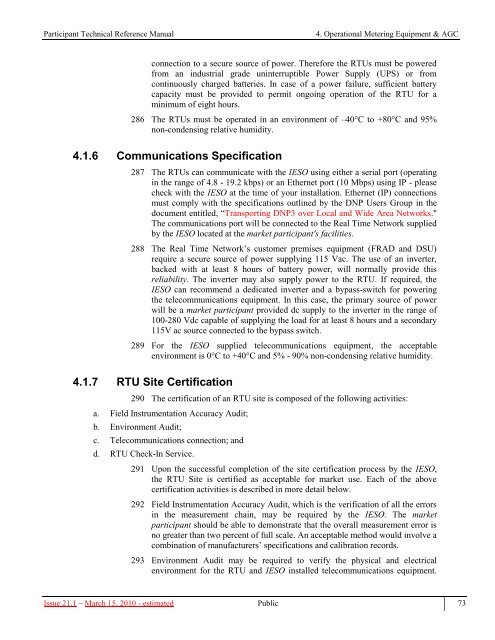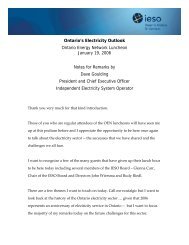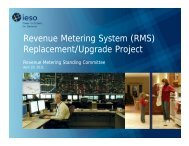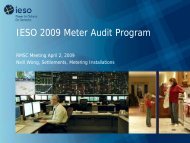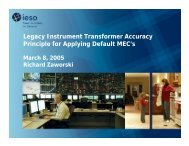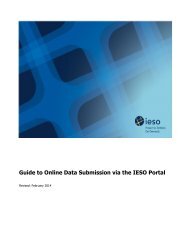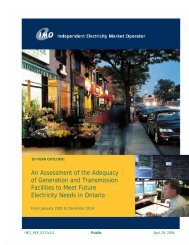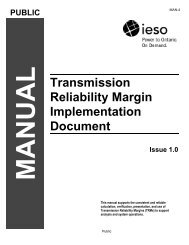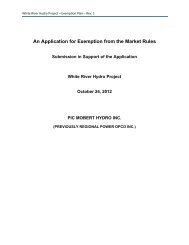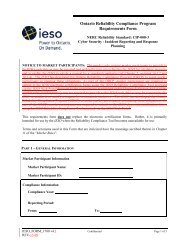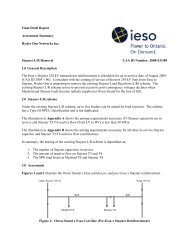Participant Technical Reference Manual - IESO
Participant Technical Reference Manual - IESO
Participant Technical Reference Manual - IESO
Create successful ePaper yourself
Turn your PDF publications into a flip-book with our unique Google optimized e-Paper software.
<strong>Participant</strong> <strong>Technical</strong> <strong>Reference</strong> <strong>Manual</strong><br />
4. Operational Metering Equipment & AGC<br />
connection to a secure source of power. Therefore the RTUs must be powered<br />
from an industrial grade uninterruptible Power Supply (UPS) or from<br />
continuously charged batteries. In case of a power failure, sufficient battery<br />
capacity must be provided to permit ongoing operation of the RTU for a<br />
minimum of eight hours.<br />
286 The RTUs must be operated in an environment of –40°C to +80°C and 95%<br />
non-condensing relative humidity.<br />
4.1.6 Communications Specification<br />
287 The RTUs can communicate with the <strong>IESO</strong> using either a serial port (operating<br />
in the range of 4.8 - 19.2 kbps) or an Ethernet port (10 Mbps) using IP - please<br />
check with the <strong>IESO</strong> at the time of your installation. Ethernet (IP) connections<br />
must comply with the specifications outlined by the DNP Users Group in the<br />
document entitled, “Transporting DNP3 over Local and Wide Area Networks."<br />
The communications port will be connected to the Real Time Network supplied<br />
by the <strong>IESO</strong> located at the market participant's facilities.<br />
288 The Real Time Network‟s customer premises equipment (FRAD and DSU)<br />
require a secure source of power supplying 115 Vac. The use of an inverter,<br />
backed with at least 8 hours of battery power, will normally provide this<br />
reliability. The inverter may also supply power to the RTU. If required, the<br />
<strong>IESO</strong> can recommend a dedicated inverter and a bypass-switch for powering<br />
the telecommunications equipment. In this case, the primary source of power<br />
will be a market participant provided dc supply to the inverter in the range of<br />
100-280 Vdc capable of supplying the load for at least 8 hours and a secondary<br />
115V ac source connected to the bypass switch.<br />
289 For the <strong>IESO</strong> supplied telecommunications equipment, the acceptable<br />
environment is 0°C to +40°C and 5% - 90% non-condensing relative humidity.<br />
4.1.7 RTU Site Certification<br />
290 The certification of an RTU site is composed of the following activities:<br />
a. Field Instrumentation Accuracy Audit;<br />
b. Environment Audit;<br />
c. Telecommunications connection; and<br />
d. RTU Check-In Service.<br />
291 Upon the successful completion of the site certification process by the <strong>IESO</strong>,<br />
the RTU Site is certified as acceptable for market use. Each of the above<br />
certification activities is described in more detail below.<br />
292 Field Instrumentation Accuracy Audit, which is the verification of all the errors<br />
in the measurement chain, may be required by the <strong>IESO</strong>. The market<br />
participant should be able to demonstrate that the overall measurement error is<br />
no greater than two percent of full scale. An acceptable method would involve a<br />
combination of manufacturers‟ specifications and calibration records.<br />
293 Environment Audit may be required to verify the physical and electrical<br />
environment for the RTU and <strong>IESO</strong> installed telecommunications equipment.<br />
Issue 21.1 – March 15, 2010 - estimated Public 73


